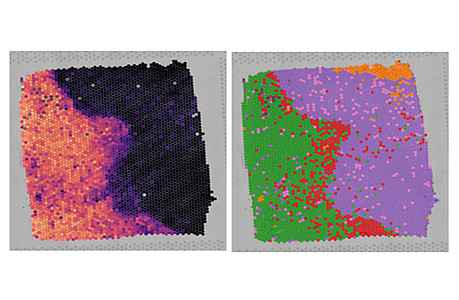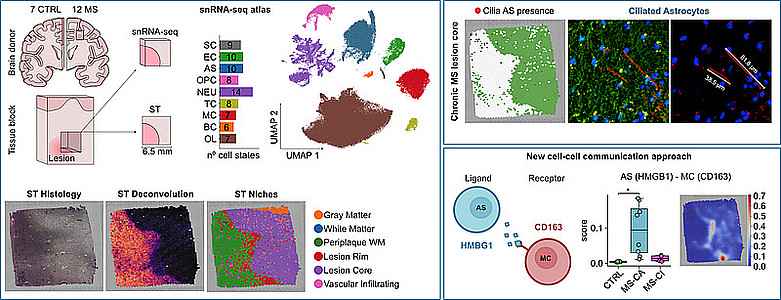Sie befinden sich hier
Inhalt
Date: 06.11.2024
Hope for new therapeutic approaches to slow down the progression of the disease
An international team of researchers led by Professor Dr. Lucas Schirmer and Professor Dr. Julio Saez-Rodriguez from the Mannheim and Heidelberg Medical Faculties of Heidelberg University has investigated the composition and communication of cells in so-called subcortical lesions, tissue damage to deep brain structures at different stages of multiple sclerosis (MS). They have gained deep insights into the molecular mechanisms that influence the progression of this chronic disease. The work has been published in the journal Nature Neuroscience.
"Our results provide valuable data on the cellular composition and the interactions between these cells in specific tissue niches that influence lesion progression in MS," explains Professor Schirmer, adding: "This knowledge opens up new therapeutic approaches that we can use to slow down the progression of the disease."
Multiple sclerosis is an inflammatory, progressive disease of the central nervous system in which the immune system attacks nerve tissue and causes permanent damage. Multiple lesions form in different regions of the nervous system, which are initially inflammatory and then evolve over time into chronic, non-inflammatory forms. A so-called chronic-active intermediate stage is characteristic, in which the lesions are surrounded by an inflamed rim, where iron deposits are often found, indicating a lack of repair mechanisms.
To more precisely map the cells and signaling pathways in these areas of tissue damage, the research team used state-of-the-art spatial and single-cell nuclear transcriptome techniques, accompanied by complex bioinformatic analyses. This enabled them to localize and analyze cell types and their signaling pathways in subcortical MS tissue and control tissue.
For example, the researchers were able to examine at high resolution areas of tissue, such as around blood vessels, that are associated with immune cell migration. They also focused on the inflamed rim and center of lesions, where they identified a specific type of astrocyte that carries cilia but has not yet been characterized in detail.
A special focus was on the inflamed edge of chronically active lesions, where the team studied interactions between myeloid, endothelial and glial cell types. These interactions contribute to the development and progression of the lesions and provide clues as to how communication processes between the cells might be specifically influenced.
"The research impressively shows how different the cell environments are at different stages of MS lesions," explain the study's first authors, Celia Lerma Martin and Pau Badia i Mompel.
"A deeper understanding of these interactions will help us to develop targeted therapies that are adapted to specific cell types and their communication in specific tissue niches," adds Professor Schirmer. Computationally intensive methods were required to analyze the large data sets. "The development and application of complex bioinformatics scripts was crucial in order to integrate and analyze the large transcriptome data sets," emphasizes Professor Saez-Rodriguez.
The work was carried out in the Division of Neuroimmunology of the Department of Neurology at the UMM led by Prof. Schirmer at the Mannheim Medical Faculty of the University of Heidelberg, in close collaboration with the Institute for Computational Biomedicine led by Prof. Saez-Rodriguez at the Heidelberg Medical Faculty. There were also collaborations with other working groups in Vienna, Heidelberg and Mannheim.
Source: press release Medical Faculty Mannheim


Press release of the Medical Faculty Mannheim (German language):
05.11.2024 Neue Erkenntnisse zu Zelltypen und Interaktionen bei der Multiplen Sklerose
Original scientific publications:
Cell type mapping reveals tissue niches and interactions in subcortical multiple sclerosis lesions.
Lerma-Martin C, Badia-i-Mompel P, Ramirez Flores RO, Sekol P, Schäfer PSL, Riedl CJ, Hofmann A, Thäwel T, Wünnemann F, Ibarra-Arellano MA, Trobisch T, Eisele P, Schapiro D, Haeussler M, Hametner S, Saez-Rodriguez J, Schirmer L.
Nature Neuroscience. 2024 November 5
DOI: 10.1038/s41593-024-01796-z
Scientific Contact:
Univ.-Prof. Dr. med. Lucas Schirmer
Heisenberg Professor of Translational Neurobiology
Division Chief Neuroimmunology
Department of Neurology, University Medical Center Mannheim
Medical Faculty Mannheim, Mannheim Center for Translational Neuroscience, Heidelberg University
Theodor-Kutzer-Ufer 1-3
68167 Mannheim
lucas.schirmer@medma.uni-heidelberg.de
